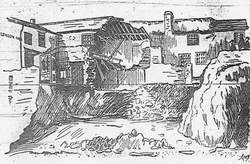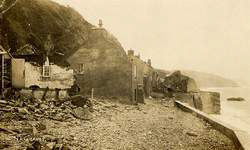Abandoned Communities ..... Hallsands
Just over a year later the first major damage occurred. On the night of 27 February 1903 the sea wall in front of the London Inn slipped forward and downward. The sea entered behind it, removing the filling at the back of the wall and undermining a conservatory attached to the inn. Either at the same time, or soon afterwards, the sea wall in front of the southernmost house in the village was destroyed, the house itself was partially wrecked, and a chasm appeared where the road had been. Other sea walls had slipped or were damaged, and a house opposite Wilson’s Rock was undermined and rendered uninhabitable.
Under the supervision of R Hansford Worth, the civil engineer mentioned earlier, construction of a new sea wall began. It was not enough to prevent frequent further destruction. In his log Hansford Worth recorded twelve dates between 24 August 1903 and 5 March 1904 when significant damage was inflicted on walls or buildings. On 20 September, for example, he wrote “Easterly storm. Kitchen, beer cellar, bedroom, and conservatory of London Inn washed away, despite all efforts to save same. Wooden boat slip at north end of village washed away. Nearly all timber broken adrift from works for short new wall opposite Wilson’s Rock.” Four days later he had to add “Wall of cellar and part of kitchen, which had been left standing at London Inn, fell, taking with it part of road.” On 12 December the sea took away the road to within three feet of the corner of a house: “Inhabitants departed, furniture and all.” Other houses were damaged beyond repair or had their foundations severely undermined.
The local Member of Parliament was Frank Mildmay. In the summer of 1903 he urged the Board of Trade to accept their responsibility for the damage to the village and provide a grant that would allow some compensation, essential repairs to buildings that could still be used, and enough to complete the construction of the new sea walls. The amount eventually agreed was £3250, comprising £2000 from the government, £1000 from Sir John Jackson, and £250 donated by Frank Mildmay himself. In taking receipt of this payment the villagers were required to undertake that it would be accepted in full and final settlement of all claims against the Board of Trade or Sir John Jackson.
At the same time a fund was started by one of the regional newspapers, the Western Morning News, to provide assistance to people who had been made homeless. The fund raised £650, and was used to build a terrace of four houses on the cliff top above the village. These were occupied by some of the people that had been made homeless, but others may have moved away from the village at this stage.
Within Hallsands itself some houses and the London Inn were repaired. For the next decade or so life returned to something like normal, although there would have been general anxiety that further major storms could bring fresh disasters. Such a storm arose on the night of Friday, 26 January 1917, when at high tide south-easterly winds drove the waves full of shingle over the sea wall and against the houses.
On Monday, 29 January 1917 one local newspaper reported as follows:
“The storm burst on Friday evening and the people living on the shore very soon saw that their houses were doomed. They speedily made their way to a place of safety at the top of the cliff, but one old lady, who was an invalid, could not be removed until the following day. Such was the fury of the waves that the householders found it difficult to save much of their belongings, and some have lost the whole of their goods and chattels.
“When morning broke a scene of desolation presented itself to the eye. The fishing boats had been tossed up clean into the meadows, wreckage was strewn about in all directions, and the village was practically wiped out. The seas swamped right over the houses, which seemed to crumple beneath their weight. Some of the people had a terrible experience. In one case there were nine people huddled together in a little house against which the waves were incessantly dashing, and they were expecting every moment that the walls which afforded them shelter would collapse, and that they would be washed away.
“One of the fishermen, James Lynn, saw two huge waves crash against his house and knock most of the front of it clean in. The lamp was extinguished, and the people were in utter darkness, but they managed to make their escape by the back door. Another home near by was levelled to the ground, and the roofs of others have been lifted off. Altogether twenty-four families have been rendered homeless. One old fisherman, sorrowfully viewing the wreckage on Saturday, said ‘This is the end of our village. We shall have to go elsewhere.’”
Under the supervision of R Hansford Worth, the civil engineer mentioned earlier, construction of a new sea wall began. It was not enough to prevent frequent further destruction. In his log Hansford Worth recorded twelve dates between 24 August 1903 and 5 March 1904 when significant damage was inflicted on walls or buildings. On 20 September, for example, he wrote “Easterly storm. Kitchen, beer cellar, bedroom, and conservatory of London Inn washed away, despite all efforts to save same. Wooden boat slip at north end of village washed away. Nearly all timber broken adrift from works for short new wall opposite Wilson’s Rock.” Four days later he had to add “Wall of cellar and part of kitchen, which had been left standing at London Inn, fell, taking with it part of road.” On 12 December the sea took away the road to within three feet of the corner of a house: “Inhabitants departed, furniture and all.” Other houses were damaged beyond repair or had their foundations severely undermined.
The local Member of Parliament was Frank Mildmay. In the summer of 1903 he urged the Board of Trade to accept their responsibility for the damage to the village and provide a grant that would allow some compensation, essential repairs to buildings that could still be used, and enough to complete the construction of the new sea walls. The amount eventually agreed was £3250, comprising £2000 from the government, £1000 from Sir John Jackson, and £250 donated by Frank Mildmay himself. In taking receipt of this payment the villagers were required to undertake that it would be accepted in full and final settlement of all claims against the Board of Trade or Sir John Jackson.
At the same time a fund was started by one of the regional newspapers, the Western Morning News, to provide assistance to people who had been made homeless. The fund raised £650, and was used to build a terrace of four houses on the cliff top above the village. These were occupied by some of the people that had been made homeless, but others may have moved away from the village at this stage.
Within Hallsands itself some houses and the London Inn were repaired. For the next decade or so life returned to something like normal, although there would have been general anxiety that further major storms could bring fresh disasters. Such a storm arose on the night of Friday, 26 January 1917, when at high tide south-
On Monday, 29 January 1917 one local newspaper reported as follows:
“The storm burst on Friday evening and the people living on the shore very soon saw that their houses were doomed. They speedily made their way to a place of safety at the top of the cliff, but one old lady, who was an invalid, could not be removed until the following day. Such was the fury of the waves that the householders found it difficult to save much of their belongings, and some have lost the whole of their goods and chattels.
“When morning broke a scene of desolation presented itself to the eye. The fishing boats had been tossed up clean into the meadows, wreckage was strewn about in all directions, and the village was practically wiped out. The seas swamped right over the houses, which seemed to crumple beneath their weight. Some of the people had a terrible experience. In one case there were nine people huddled together in a little house against which the waves were incessantly dashing, and they were expecting every moment that the walls which afforded them shelter would collapse, and that they would be washed away.
“One of the fishermen, James Lynn, saw two huge waves crash against his house and knock most of the front of it clean in. The lamp was extinguished, and the people were in utter darkness, but they managed to make their escape by the back door. Another home near by was levelled to the ground, and the roofs of others have been lifted off. Altogether twenty-
Three
The London Inn after the storms of 1903.
The Western Morning News houses in April 2007
Another view of the damage to the London Inn: a sketch published in the Western Daily Mercury on 23 September 1903
After the storm of January 1917



